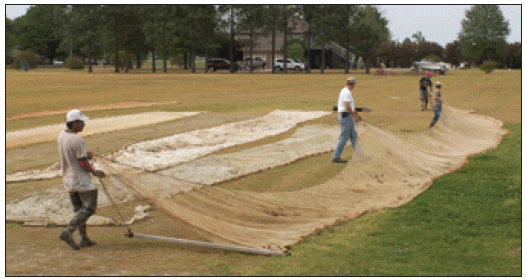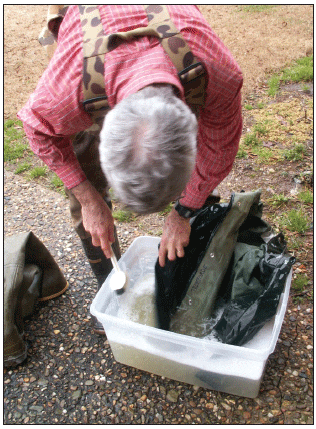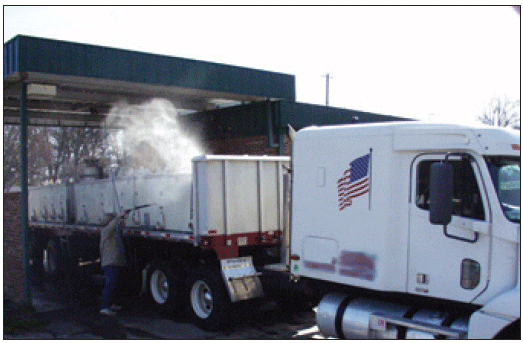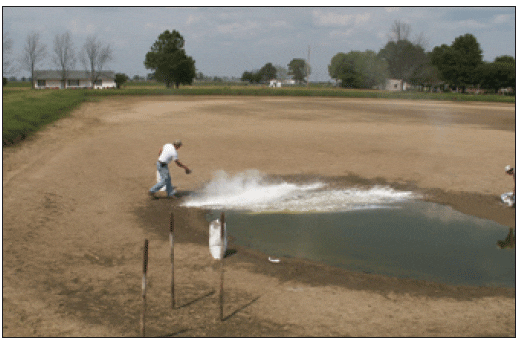Diseases can cause serious problems on fish farms. They may decimate fish stocks or make a farmer’s products unmarketable. The discovery of exotic diseases on fish farms can trigger huge financial losses associated with state and federal quarantines and fish eradication. Farmers who can document the health status of their fish have a competitive advantage with customers and regulators, who recognize the benefits of a safer product. These advantages can be realized by fairly simple changes in farm management practices that help prevent the introduction and spread of disease.
Fish diseases caused by parasites, bacteria or viruses can be spread from pond to pond or from farm to farm by the transfer of infected fish and by animals, people, equipment and water contaminated by contact with infected fish or fish pathogens. To prevent the introduction of new diseases onto a fish farm, there should be no contact between the fish on the farm and any potential disease carriers. Farm equipment should be cleaned and disinfected before each use. Workers should disinfect clothing, boots and other gear before having contact with healthy fish. Sanitation is particularly important in preventing the spread of disease between ponds or vats when sick fish are present.
Fish
Wild fish, fish from other farms, and fish returned to the farm after being handled off-farm can carry diseases. Fish should be inspected for known diseases, at either the lot or farm level, by a fish health professional before they are brought onto the farm. If possible, new or returned fish should be quarantined in ponds or facilities as far as practical from the rest of the farm. No fish or water should be allowed to escape from quarantine facilities. The equipment used in quarantine facilities should not be moved to non-quarantined areas until it has been disinfected. A quarantine period must last until the fish are exposed to the full range of seasonal water temperatures at which any disease of concern can be detected. For example, quarantining fish at winter water temperatures to protect against a disease that occurs only at warm water temperatures is not an effective strategy. The Spring Viremia of Carp Virus (SVCV) occurs at water temperatures of 10 to 18 °C, so new carp or goldfish stock must be quarantined at cool water temperatures so that SVCV carriers can be detected.
Water
The safest water for fish production is water pumped straight from a well to the pond. Water that is recirculated or reused on the farm for different batches of fish is not likely to be the source of new diseases, but it may enable existing pathogens to accumulate in either the fish or in intermediate hosts held in the reused pond water. River water is the least desirable source of water for fish farming because it is likely to contain pathogens not already present on the fish farm. If river water must be used, pump it through a fine filter and hold it in fish-free ponds for at least 21 days before using it. This will interrupt the life cycles of parasites that cannot survive without a suitable fish host.
Holding fish-free water in a reservoir before use will also give any bacterial or viral pathogens time to deteriorate in the absence of a suitable host. Specialized water treatment facilities that incorporate ozone treatment and ultraviolet light sterilization processes can be used to disinfect river water. However this technology is expensive and is economically feasible only if the farmer is producing a high-value fish product.
Animals
A number of animals that live in or move around fish ponds can carry fish diseases. Of these, birds are the greatest concern. There is evidence that birds can transmit bacteria and viruses through their droppings. Birds can also drop fish from one body of water into another. Several species of fisheating birds can carry the life stages of parasites (trematodes or “grubs”) that infest snails in culture ponds and then develop into parasites of fish. To reduce this problem, use the most effective legal means of discouraging birds from visiting farm ponds. Talk about this with your local USDAAPHIS animal control specialist. Controlling snails is beneficial where trematodes are a problem for the fish species being cultured.

Equipment
Fish diseases are easily transferred on wet, slime-laden or muddy equipment. In fact, exposing fish to fresh slime is almost as risky as exposing them to new fish. Drying equipment such as seines (Fig. 1) before each use kills many fish pathogens. Better yet, use warm water and detergents to clean equipment such as buckets, boots, waders and vehicles and then dry them (Fig. 2). Transport trucks and other vehicles can be cleaned easily with a high-pressure hose at the local carwash (Fig. 3). For the best results in killing pathogens, you must clean, disinfect and dry equipment before it is used elsewhere on or off the farm. This is especially critical for equipment that has been used to handle, harvest or transport sick fish.

It is important to know that some disinfectants will not work effectively in the presence of dirt and organic matter such as fish mucous. Equipment must be thoroughly scrubbed clean with a brush and detergent and then rinsed to remove any dirt and detergent residue. Then an appropriate disinfectant should be applied and left on the equipment long enough to kill disease organisms. Rinsing after disinfection ensures that no residues are left behind. Drying equipment in the sun will destroy bacteria or viruses that may have survived. The choice of chemical cleaner or disinfectant is critical. Consider the type of disease organism you are trying to control and the type of equipment you are disinfecting, as well as the cost and safety of the chemical. Methods of cleaning and disinfecting are shown in Table 1.

| Cleaning and Disinfecting Methods for use Against Bacteria and Viruses. | |
|---|---|
| Item | Method |
| People (hands, skin, hair) | Scrub clean with soapy water. Rinse and dry. |
| Clothes | Clean with soapy water. Rinse and soak in bleach or Virkon® (as per instructions). Rinse. Dry. |
| Plastic buckets, rubber boots, waders, wet suits | Scrub clean with a detergent, then rinse with water and disinfect with appropriate disinfectant, for example Virkon® (as per instructions) or 200 ppm iodine (1?3 cup of iodine solution with 1% active ingredient per gallon of water). Then dry. |
| Netting (dip nets, seine nets) | Clean with a detergent. Rinse and dry. OR Clean and immerse in 1000 ppm sodium hypochlorite (1?4 cup of sodium hypochlorite solution [bleach] with 6% active ingredient per gallon of water) solution for 6 hours. Then rinse in fresh water and dry. OR Immerse in a 6% solution of calcium hypochlorite (1?2 pound of calcium hypochlorite powder = HTH swimming pool chlorinator with 47% available chlorine per gallon) for 5 minutes. Rinse and dry. OR 200 to 250 ppm iodine (250 ppm = 0.4 cups of iodine solution with 1% active ingredient per gallon of water). Rinse and dry. OR 50 ppm formalin (37% formaldehyde) (1?3 teaspoon of formalin per 10 gallons of water). Rinse and dry. OR 1% sodium hydroxide (1?3 cup of sodium hydroxide solution with 50% active ingredient per gallon of water). Rinse and dry. |
| Transport tanks | Scrub clean with detergent. Rinse and spray with 200 to 250 ppm iodine. Rinse and dry. |
| Vehicles and transport trucks | Remove all solid debris and loose equipment. Clean the outside of vehicle and transport tanks at an automated carwash. Clean, rinse and disinfect the inside surfaces of transport tanks, including aeration equipment, pipes and pumps inside transport tanks, with iodine. Rinse and dry. |
| Pond bottom mud, pond surfaces, pond water | Drain all water. Remove all fish and vegetation. Add hydrated lime (1300 pounds per acre). Dry. Most, but not all, viruses and bacteria may be killed by adding hydrated lime to raise water pH to 11 for at least 1 hour. |
| Infected fish | Harvest or cull. Store and transport dead fish in leak-proof containers (like harvest bins double-lined with plastic bags). For disposal, cover the dead fish with hydrated lime and bury them at a depth and site that meets the requirements of regulatory agencies. |
| Wooden structures (pallets, platforms and sluice gates) | Wood is a porous material so disinfection is difficult. Burn or bury contaminated wooden structures, or transport them off-site. |
| Please note: The dilutions listed in this table are correct only for the percentage of active ingredient specified for each product. The required dilution rate of a product will change according to its active ingredient concentration. Please consult your extension specialist if you need assistance with determining product dilutions and measurement. | |
Some viruses may be killed easily by detergents alone, while others are very hard to kill except with very specific disinfectants. Some bacteria found in recirculating aquaculture systems (mycobacteria, which cause fish-handler’s disease) are also very hard to kill. Most detergent-resistant bacteria and viruses can be killed with a single broad-spectrum disinfectant such as sodium hydroxide (a strong alkali), formalin (an aldehyde), chlorine, iodine, or a peroxide product (such as Virkon®).
Many parasites are relatively easy to destroy with disinfectants. However, some parasites, such as the Myxozoa, produce spores that are difficult to inactivate. Other parasites, including many Monogenea and Crustacea, produce eggs that can be resistant to many disinfectants. Parasites usually can be physically removed by thoroughly scrubbing equipment. Soaking the cleaned equipment in formalin or a peroxide product will kill most types of parasites that may still be present. Soaking is a very effective way to decontaminate nets and airstones, which are hard to scrub clean. The best way to disinfect ponds is to dry them and treat them with hydrated lime to kill some parasites and their intermediate hosts (Fig. 4).
Aquatic fungi produce motile zoospores, which are susceptible to most disinfectants except during a brief period of encystment.
It is important to consider the safety and handling limitations of the chemicals used for cleaning and disinfection. Remember that some chemical agents may be harmful to the user or to fish and may leave toxic residues or damage equipment. Some agents, such as iodine, stain equipment; others, like hypochlorite, are corrosive to metals and netting, as well as being toxic to fish. It is possible to neutralize hypochlorite with sodium thiosulfate. Consult with your fish health specialist to determine the best choice of cleaning and disinfecting agents to use on your farm. Some basic guidelines are provided in Table 1.
In summary, prevent diseases by scrubbing equipment with warm, soapy water and then drying the equipment thoroughly before reuse. Clean, rinse and dry trucks, seines and other equipment used for fish from another facility or fish from the wild. Applying a broad-spectrum disinfectant to cleaned equipment gives further protection to your fish stocks.





